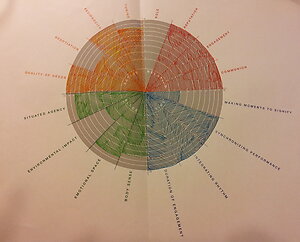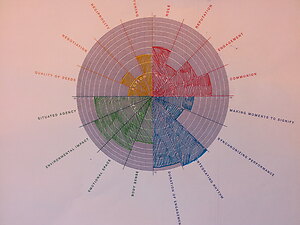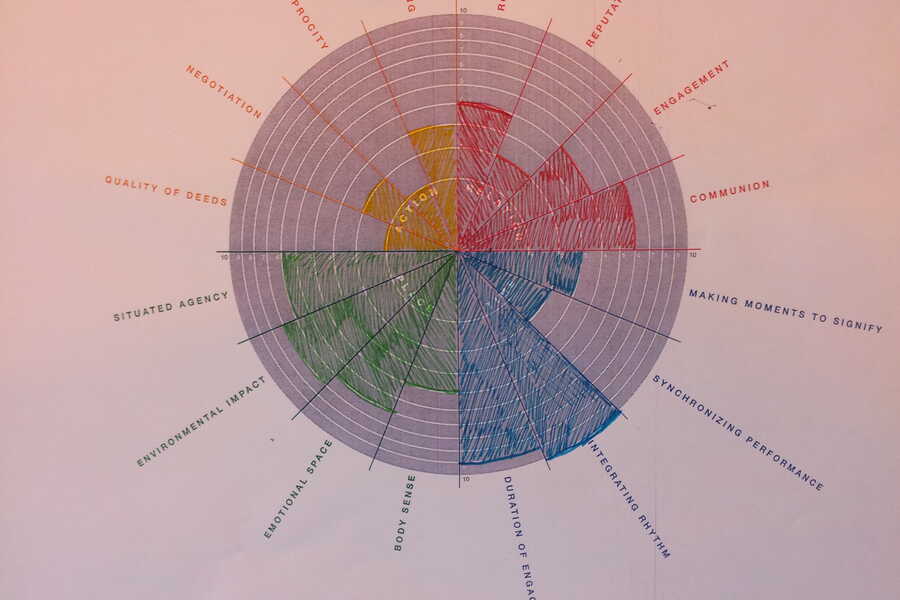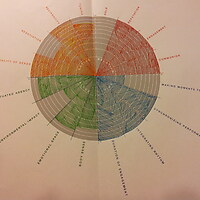
Figure 4.1. Future sub-system.

Figure 4.2. Current sub-system.
4.1 Action
As the figures (4.1 and 4.2) show, the current sub-system is believed to have low reciprocity, negotiation and quality of deeds and medium tuning. The future sub-system is intended to increase both reciprocity and quality of deeds since both of those parameters are important for a mobility system. Also tuning and negotiation are increased in the future system. Action is vital for a transportation system to function, and especially that people experience quality of deeds and that they are working with the system. When they give, they get something in return.
4.2 Relation
Relation is an interesting chapter in this YUTPA. The future sub-system has full impact on all parameters except for role (see figures 1 and 2). Currently, it is believed that the role plays too big a part, and that it should be reduced for the mobility system. Everyone should be treated as equals in this system, and personal life should not affect the possibility of traveling in a more sustainable way. Since Texelaars have a strong identity (Frantzeskaki , Avelino , & Loorbach , 2013), it seems reasonable to increase the impact of communion, engagement and reputation of the mobility system to the fullest extent. Currently the role plays too big a part and the reputation is too low. A greater (positive) reputation can contribute to tourism, as was explained in chapter 3.
4.3 Place
Situated agency and body sense are believed to have a higher impact in the future system compared to the current system. It is believed that the new system will generate a greater feeling in people and that there will be a feeling of productivity in the new system. Environmental impact (negative) is decreased and emotional space is increased in the future system compared to the current system. Environmental impact should of course be smaller since this system aspires to be sustainable. Emotional space is increased since the sense of "being here" should be stronger in the future sub-system.
4.4 Time
Figures 1 and 2 show that synchronizing performance, integrating rhythm and duration of engagement have full impact in the future sub-system. Moments to signify, however, does not change much from the current sub-system, since the mobility system is meant to be an everyday-activity for the Texelaars. Synchronizing performance and integrating rhythm are very important for a mobility system as it needs to be adapted to other activities and and the life rhythm of Texelaars. Duration of engagement should be long, transportation needs to be a long-term investment. It is hard to make an infrastructure change in just a few months, but it is possible to make change happen over 5 years or a decade. As innovation and technology evolves, so must the island.
4.5 Other factors
This analysis focuses on residents, but tourists will also see a change in the future sub-system. The biggest change for tourists between the two systems will be the cableway, which will function not only as a mode of transportation, but also as an attraction in itself. This would increase making moments to signify for the tourist. Tourists will also be able to travel in a cleaner way than before, with electric cars and together in eco-friendly minibuses (see chapter 3), which also will add to the reputation of the island as “green and clean”.
New technologies will be present in the future system, such as automated and electric vehicles. This means that new actors will become involved, for example companies that produce charging poles, and replace actors such as petrol stations. The legal framework will be the same in the future system, but laws might need to be tweaked in the future to fit this new reality. For instance, speed limits for electric bikes (see chapter 2.4).
References
Frantzeskaki, N., Avelino, F., & Loorbach, D. (2013). Outliers or Frontrunners? Exploring the (Self-) Governance of Community- Owned Sustainable Energy in Scotland and the Netherlands . Energy (23).



